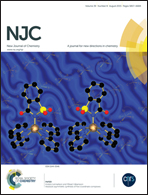Gold nanorods-paper electrode based enzyme-free electrochemical immunoassay for prostate specific antigen using porous zinc oxide spheres–silver nanoparticles nanocomposites as labels†
Abstract
An ultrasensitive enzyme-free electrochemical immunosensor is constructed using a gold nanorods (AuNRs) modified paper electrode as the sensor platform and porous zinc oxide spheres (PZS)–silver nanoparticles (AgNPs) nanocomposites as signal labels. Significantly enhanced sensitivity for prostate specific antigen (PSA) comes from a dual signal amplification strategy. First, interconnected AuNRs layers, which can improve the electronic transmission rate, are grown on the surface of cellulose fibers on a paper sample zone to capture primary antibodies. Second, PZS, a porous material with large surface area, is synthesized to provide sites for AgNPs loading, which improves the catalytic capacity of the AgNPs towards H2O2 reduction. Under optimized conditions, the proposed immunosensor for PSA exhibits a wide linear detection range from 0.004 to 60 ng mL−1 with a detection limit of 1.5 pg mL−1. Moreover, the immunosensor shows excellent selectivity, high stability, and acceptable fabrication reproducibility. This strategy appears to be a simple method, which provides a promising platform for the detection of other proteins.



 Please wait while we load your content...
Please wait while we load your content...